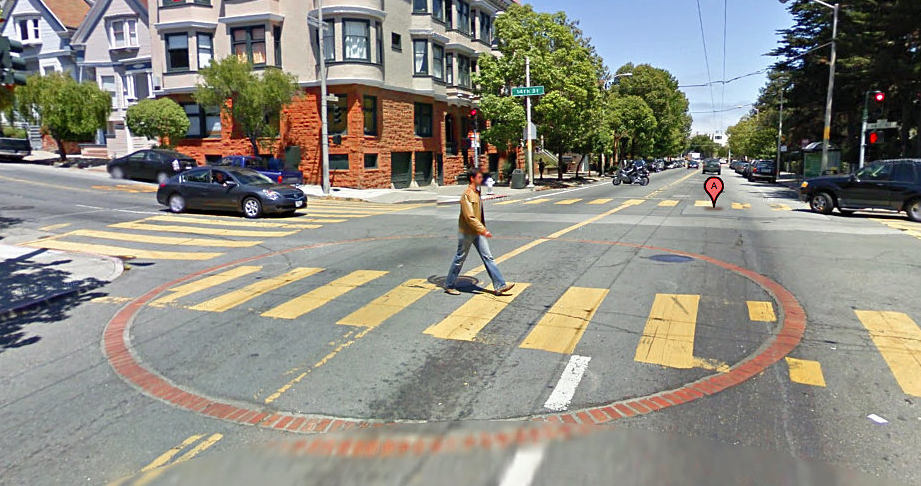The Strange Brick Circles of San Francisco

Pictured above is a San Francisco intersection. The image (via here) is from Google Street View, and except for a significant feature, it could have otherwise been an intersection from virtually anywhere. But, as you can plainly see, there’s something strange in the middle of the road: a circle of bricks seemingly ringing part, but not all, of one of the crosswalks.
These brick circles are all around San Francisco, puzzling tourists and more often than not, residents as well. The circles are almost always in the middle of streets and near intersections, and often seem to coincide with trolley tracks. (San Francisco is home to the last manually-operated cable car system in the world, but the service area is much more limited than it used to be). But they have nothing to do with transit, nor are they part of a massive public art installation.
They’re a public safety feature.
At 5:12 in the morning of April 12, 1906, San Francisco was struck by a 7.9 magnitude earthquake. As the USGS recounts, “violent shocks punctuated the strong shaking which lasted some 45 to 60 seconds. The earthquake was felt from southern Oregon to south of Los Angeles and inland as far as central Nevada.” The immediate damage was immense, destroying buildings and claiming hundreds of lives. But the danger was only beginning. A series of fires broke out throughout the city, burning for days. In total, more than three-quarters of the city was destroyed, and as many as 3,000 people died in the earthquake and its aftermath.
Typically — even more than a century ago — city fire departments are able to put out fires more quickly. The existing infrastructure allows the firefighters to get to the fires; similarly, municipal fire hydrants, connected by water mains, allow these responders to attack the fires without having to bring water along with their ladders and hoses. But the 1906 earthquake destroyed a lot of that infrastructure. As Atlas Obscura explains, “water and sewage lines were severed by the shock, and the roads quickly filled with rubble, making them all but impassable to fire carriages dependent on horse-power and small portable tanks of water.” While firefighters could reach the blaze, they didn’t have the water needed to put out the fires.
The solution was to turn back the clock. In the 1800s, fire struck the city a number of times; as a result, per KQED, “city leaders built 16 underground cisterns around San Francisco to store water for firefighting.” But, KQED continues, “as the city grew, more cisterns were installed. But the city also started to install water pipes and hydrants. By the end of the 1800s, residents had full faith in their new water system, and the cisterns stopped being maintained.” When tragedy struck in 1906, many of the cisterns had run dry. The few that hadn’t fallen into disrepair, though, were used by firefighters to successfully put out some of the fires.
Starting in 1908, the city began repairing the existing cisterns and building more than a hundred new ones. They’re basically massive tanks of water, separate from the municipal water supply, waiting in case the regular water systems fail. (Here is what one — an above-ground one — looks like empty, via the SF Public Utilities Commission.) Most of the cisterns are below street-level, and before GPS, firefighters needed to know where they were during an emergency. The brick rings solved that problem and created a mysterious little art project as a bonus.
Bonus fact: The1906 earthquake was almost certainly made worse by a horrible decision by the mayor. Federal troops joined local police in San Francisco to help with the recovery, but Mayor Eugene Schmitz wanted the combined law enforcement to go further. As seen here, the mayor “authorized [them] to KILL any and all persons found engaged in Looting or in Commission of Any Other Crime” (capitalization as in the original). It’s unknown how many extrajudicial killings took place, if any, but according to subsequent reports, many of the federal soldiers were themselves accused of looting.
From the Archives: The Ladder Shop: Wood burns. But San Francisco’s fire department uses wood ladders. Here’s that story.
